Blog & Latest Updates
Fly Fishing Articles
Insects by Common Name


Updates from March 1, 2004
Videos by Troutnut from the Marengo River and Miscellaneous Wisconsin in Wisconsin
Another Hexagenia
Starring: Hexagenia limbata Mayfly Nymph
StateWisconsin
LocationMarengo River
Date ShotMar 1, 2004
Date AddedMar 31, 2006
AuthorTroutnut
CameraOlympus C740UZ
Two Phryganeidae caddis larvae fighting over a case
Starring: Phryganeidae Caddisfly Larva
Caddisfly larvae of this family can easily leave and re-enters their cases. I caught two of them playing musical chairs or something with this one... funny!
StateWisconsin
Locationunknown
Date ShotMar 1, 2004
Date AddedMar 31, 2006
AuthorTroutnut
CameraOlympus C740UZ
Photos by Troutnut from the Marengo River and the West Fork of the Chippewa River in Wisconsin
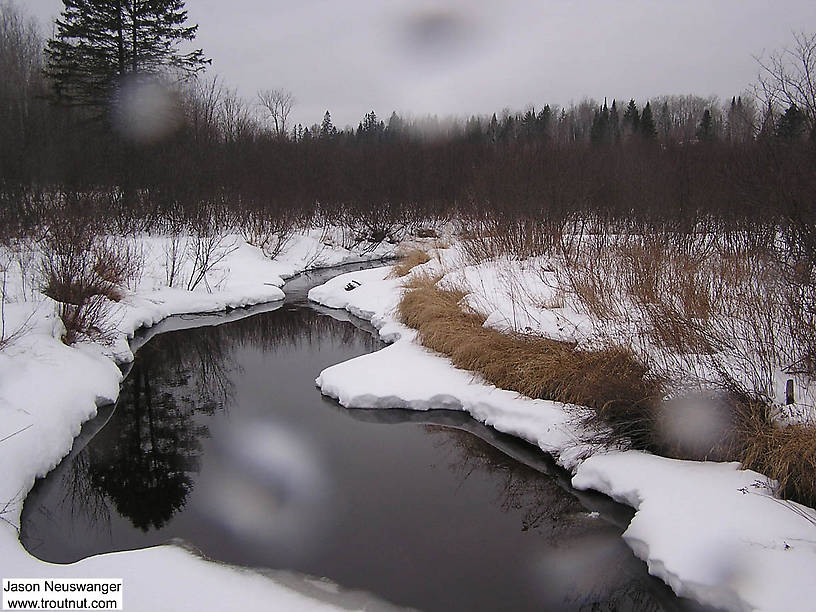
I had excellent luck sampling burrowing mayfly nymphs here in the headwaters of a trouty small stream.
StateWisconsin
LocationMarengo River
Date TakenMar 1, 2004
Date AddedJan 25, 2006
AuthorTroutnut
CameraOlympus C740UZ

I had to really search for a while to find a sliver of opening water at this sampling site far in the headwaters of a mighty warmwater river.
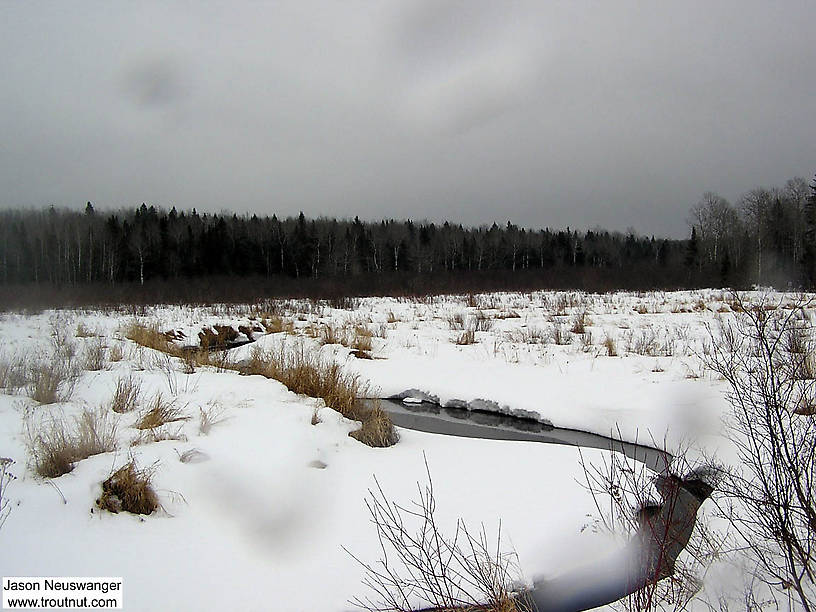
I had excellent luck sampling burrowing mayfly nymphs here in the headwaters of a trouty small stream.
StateWisconsin
LocationMarengo River
Date TakenMar 1, 2004
Date AddedJan 25, 2006
AuthorTroutnut
CameraOlympus C740UZ
Closeup insects by Troutnut from Miscellaneous Wisconsin and the West Fork of the Chippewa River in Wisconsin
Hexagenia limbata (Hex) Mayfly Nymph View 7 Pictures
View 7 Pictures
 View 7 Pictures
View 7 PicturesCollected March 1, 2004 from unknown in Wisconsin
Added to Troutnut.com by Troutnut on January 25, 2006
Added to Troutnut.com by Troutnut on January 25, 2006
Limnephilidae (Northern Caddisflies) Caddisfly Larva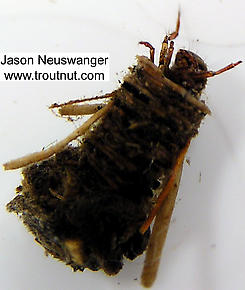 View 5 Pictures
View 5 Pictures
 View 5 Pictures
View 5 PicturesCollected March 1, 2004 from unknown in Wisconsin
Added to Troutnut.com by Troutnut on January 25, 2006
Added to Troutnut.com by Troutnut on January 25, 2006
Phryganeidae Caddisfly Larva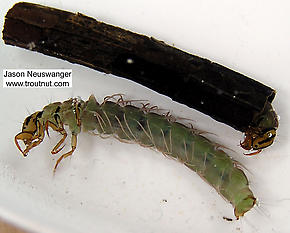 View 5 PicturesThis "specimen" is actually two caddis larvae fighting each other over a case. The case is a hollow tube; one larva would go in the back end, presumably bite the other, and chase it out. The invader crawled forward into the case while the other one fled, and then it went around to the back and bit the first one. They did this several times, and I recorded it on video.
View 5 PicturesThis "specimen" is actually two caddis larvae fighting each other over a case. The case is a hollow tube; one larva would go in the back end, presumably bite the other, and chase it out. The invader crawled forward into the case while the other one fled, and then it went around to the back and bit the first one. They did this several times, and I recorded it on video.
 View 5 PicturesThis "specimen" is actually two caddis larvae fighting each other over a case. The case is a hollow tube; one larva would go in the back end, presumably bite the other, and chase it out. The invader crawled forward into the case while the other one fled, and then it went around to the back and bit the first one. They did this several times, and I recorded it on video.
View 5 PicturesThis "specimen" is actually two caddis larvae fighting each other over a case. The case is a hollow tube; one larva would go in the back end, presumably bite the other, and chase it out. The invader crawled forward into the case while the other one fled, and then it went around to the back and bit the first one. They did this several times, and I recorded it on video.Collected March 1, 2004 from unknown in Wisconsin
Added to Troutnut.com by Troutnut on January 25, 2006
Added to Troutnut.com by Troutnut on January 25, 2006
Leptophlebia cupida (Borcher Drake) Mayfly Nymph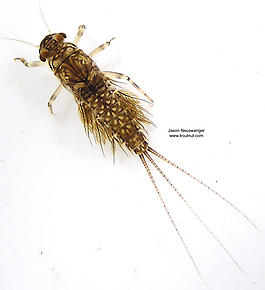 View 5 Pictures
View 5 Pictures
 View 5 Pictures
View 5 PicturesCollected March 1, 2004 from the West Fork of the Chippewa River, Headwaters in Wisconsin
Added to Troutnut.com by Troutnut on January 25, 2006
Added to Troutnut.com by Troutnut on January 25, 2006
Simuliidae (Black Flies) Black Fly Larva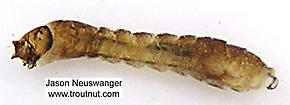 View 4 Pictures
View 4 Pictures
 View 4 Pictures
View 4 PicturesCollected March 1, 2004 from unknown in Wisconsin
Added to Troutnut.com by Troutnut on January 25, 2006
Added to Troutnut.com by Troutnut on January 25, 2006
Cordulegaster Dragonfly Nymph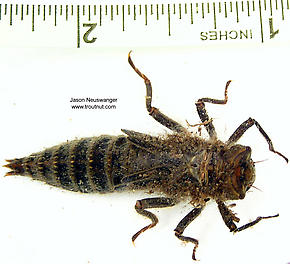 View 4 Pictures
View 4 Pictures
 View 4 Pictures
View 4 PicturesCollected March 1, 2004 from unknown in Wisconsin
Added to Troutnut.com by Troutnut on January 25, 2006
Added to Troutnut.com by Troutnut on January 25, 2006
Chimarra (Little Black Sedges) Caddisfly Larva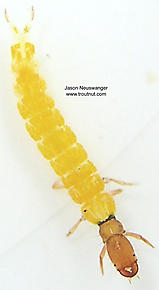 View 4 Pictures
View 4 Pictures
 View 4 Pictures
View 4 PicturesCollected March 1, 2004 from unknown in Wisconsin
Added to Troutnut.com by Troutnut on January 25, 2006
Added to Troutnut.com by Troutnut on January 25, 2006
Hagenius brevistylus Dragonfly Nymph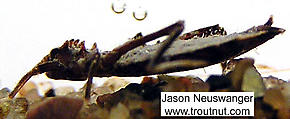 View 4 Pictures
View 4 Pictures
 View 4 Pictures
View 4 PicturesCollected March 1, 2004 from unknown in Wisconsin
Added to Troutnut.com by Troutnut on January 25, 2006
Added to Troutnut.com by Troutnut on January 25, 2006
Siphloplecton basale (Pseudo-Gray Drake) Mayfly Nymph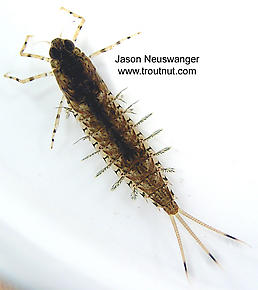 View 4 PicturesThis nymph has double front tarsal claws (Tarsal claw: The claws at the tip of the tarsus, on an insect's "foot.") and double gills on the first three abdominal segments.
View 4 PicturesThis nymph has double front tarsal claws (Tarsal claw: The claws at the tip of the tarsus, on an insect's "foot.") and double gills on the first three abdominal segments.
 View 4 PicturesThis nymph has double front tarsal claws (Tarsal claw: The claws at the tip of the tarsus, on an insect's "foot.") and double gills on the first three abdominal segments.
View 4 PicturesThis nymph has double front tarsal claws (Tarsal claw: The claws at the tip of the tarsus, on an insect's "foot.") and double gills on the first three abdominal segments.Collected March 1, 2004 from unknown in Wisconsin
Added to Troutnut.com by Troutnut on January 25, 2006
Added to Troutnut.com by Troutnut on January 25, 2006
Siphloplecton basale (Pseudo-Gray Drake) Mayfly Nymph View 4 PicturesThis nymph has double front tarsal claws (Tarsal claw: The claws at the tip of the tarsus, on an insect's "foot.") and double gills on the first three abdominal segments.
View 4 PicturesThis nymph has double front tarsal claws (Tarsal claw: The claws at the tip of the tarsus, on an insect's "foot.") and double gills on the first three abdominal segments.
 View 4 PicturesThis nymph has double front tarsal claws (Tarsal claw: The claws at the tip of the tarsus, on an insect's "foot.") and double gills on the first three abdominal segments.
View 4 PicturesThis nymph has double front tarsal claws (Tarsal claw: The claws at the tip of the tarsus, on an insect's "foot.") and double gills on the first three abdominal segments.Collected March 1, 2004 from unknown in Wisconsin
Added to Troutnut.com by Troutnut on January 25, 2006
Added to Troutnut.com by Troutnut on January 25, 2006
Ephemera simulans (Brown Drake) Mayfly Nymph View 4 Pictures
View 4 Pictures
 View 4 Pictures
View 4 PicturesCollected March 1, 2004 from unknown in Wisconsin
Added to Troutnut.com by Troutnut on January 25, 2006
Added to Troutnut.com by Troutnut on January 25, 2006
Hexagenia limbata (Hex) Mayfly Nymph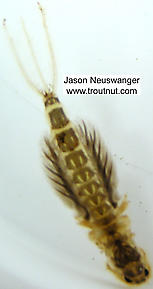 View 4 Pictures
View 4 Pictures
 View 4 Pictures
View 4 PicturesCollected March 1, 2004 from unknown in Wisconsin
Added to Troutnut.com by Troutnut on January 25, 2006
Added to Troutnut.com by Troutnut on January 25, 2006
Hexagenia limbata (Hex) Mayfly Nymph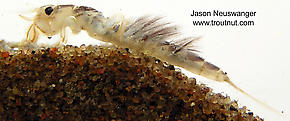 View 4 Pictures
View 4 Pictures
 View 4 Pictures
View 4 PicturesCollected March 1, 2004 from unknown in Wisconsin
Added to Troutnut.com by Troutnut on January 25, 2006
Added to Troutnut.com by Troutnut on January 25, 2006
Leptophlebia cupida (Borcher Drake) Mayfly Nymph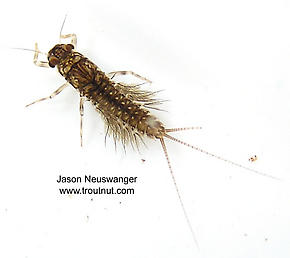 View 4 Pictures
View 4 Pictures
 View 4 Pictures
View 4 PicturesCollected March 1, 2004 from the West Fork of the Chippewa River, Headwaters in Wisconsin
Added to Troutnut.com by Troutnut on January 25, 2006
Added to Troutnut.com by Troutnut on January 25, 2006
Taeniopteryx (Early Black Stoneflies) Stonefly Nymph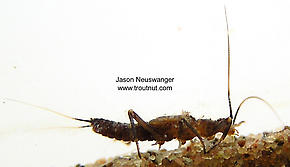 View 4 Pictures
View 4 Pictures
 View 4 Pictures
View 4 PicturesCollected March 1, 2004 from unknown in Wisconsin
Added to Troutnut.com by Troutnut on January 25, 2006
Added to Troutnut.com by Troutnut on January 25, 2006
Limnephilidae (Northern Caddisflies) Caddisfly Larva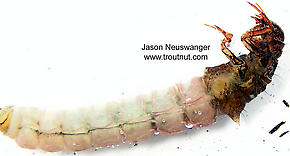 View 4 Pictures
View 4 Pictures
 View 4 Pictures
View 4 PicturesCollected March 1, 2004 from unknown in Wisconsin
Added to Troutnut.com by Troutnut on January 25, 2006
Added to Troutnut.com by Troutnut on January 25, 2006
Molanna (Gray Checkered Sedges) Caddisfly Larva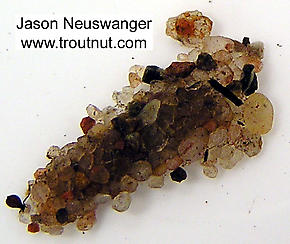 View 4 Pictures
View 4 Pictures
 View 4 Pictures
View 4 PicturesCollected March 1, 2004 from unknown in Wisconsin
Added to Troutnut.com by Troutnut on January 25, 2006
Added to Troutnut.com by Troutnut on January 25, 2006
Clitellata-Hirudinae (Leeches) Leech Adult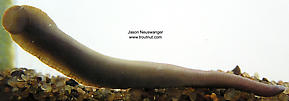 View 3 Pictures
View 3 Pictures
 View 3 Pictures
View 3 PicturesCollected March 1, 2004 from unknown in Wisconsin
Added to Troutnut.com by Troutnut on January 25, 2006
Added to Troutnut.com by Troutnut on January 25, 2006
Leptophlebia cupida (Borcher Drake) Mayfly Nymph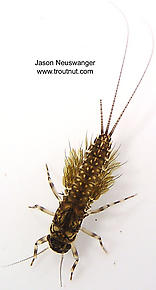 View 3 Pictures
View 3 Pictures
 View 3 Pictures
View 3 PicturesCollected March 1, 2004 from unknown in Wisconsin
Added to Troutnut.com by Troutnut on January 25, 2006
Added to Troutnut.com by Troutnut on January 25, 2006
Hexagenia limbata (Hex) Mayfly Nymph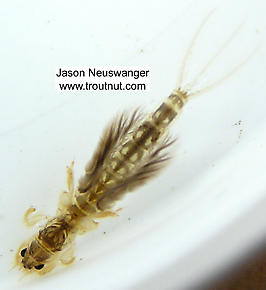 View 3 Pictures
View 3 Pictures
 View 3 Pictures
View 3 PicturesCollected March 1, 2004 from unknown in Wisconsin
Added to Troutnut.com by Troutnut on January 25, 2006
Added to Troutnut.com by Troutnut on January 25, 2006
Onocosmoecus unicolor (Great Late-Summer Sedge) Caddisfly Larva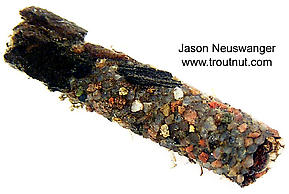 View 3 Pictures
View 3 Pictures
 View 3 Pictures
View 3 PicturesCollected March 1, 2004 from unknown in Wisconsin
Added to Troutnut.com by Troutnut on January 25, 2006
Added to Troutnut.com by Troutnut on January 25, 2006
Siphloplecton basale (Pseudo-Gray Drake) Mayfly Nymph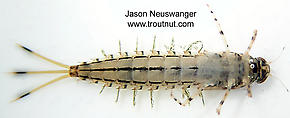 View 4 PicturesThis nymph has double front tarsal claws (Tarsal claw: The claws at the tip of the tarsus, on an insect's "foot.") and double gills on the first three abdominal segments.
View 4 PicturesThis nymph has double front tarsal claws (Tarsal claw: The claws at the tip of the tarsus, on an insect's "foot.") and double gills on the first three abdominal segments.
 View 4 PicturesThis nymph has double front tarsal claws (Tarsal claw: The claws at the tip of the tarsus, on an insect's "foot.") and double gills on the first three abdominal segments.
View 4 PicturesThis nymph has double front tarsal claws (Tarsal claw: The claws at the tip of the tarsus, on an insect's "foot.") and double gills on the first three abdominal segments.Collected March 1, 2004 from unknown in Wisconsin
Added to Troutnut.com by Troutnut on January 25, 2006
Added to Troutnut.com by Troutnut on January 25, 2006
Baetisca laurentina (Armored Mayfly) Mayfly Nymph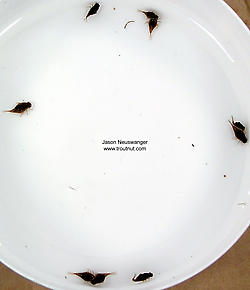 View 3 PicturesI took a few group picture of a bunch of Baetisca laurentina nymphs to show the degree of individual variation in size, color, and shape that can occur within the same species in the same pool of the same river. This variation is one important reason why trout are forgiving of some small degree of variation in our imitations--the naturals themselves vary, too.
View 3 PicturesI took a few group picture of a bunch of Baetisca laurentina nymphs to show the degree of individual variation in size, color, and shape that can occur within the same species in the same pool of the same river. This variation is one important reason why trout are forgiving of some small degree of variation in our imitations--the naturals themselves vary, too.
 View 3 PicturesI took a few group picture of a bunch of Baetisca laurentina nymphs to show the degree of individual variation in size, color, and shape that can occur within the same species in the same pool of the same river. This variation is one important reason why trout are forgiving of some small degree of variation in our imitations--the naturals themselves vary, too.
View 3 PicturesI took a few group picture of a bunch of Baetisca laurentina nymphs to show the degree of individual variation in size, color, and shape that can occur within the same species in the same pool of the same river. This variation is one important reason why trout are forgiving of some small degree of variation in our imitations--the naturals themselves vary, too.Collected March 1, 2004 from unknown in Wisconsin
Added to Troutnut.com by Troutnut on January 25, 2006
Added to Troutnut.com by Troutnut on January 25, 2006
Ephemera simulans (Brown Drake) Mayfly Nymph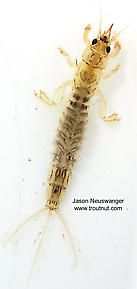 View 3 Pictures
View 3 Pictures
 View 3 Pictures
View 3 PicturesCollected March 1, 2004 from unknown in Wisconsin
Added to Troutnut.com by Troutnut on January 25, 2006
Added to Troutnut.com by Troutnut on January 25, 2006
Ephemera simulans (Brown Drake) Mayfly Nymph View 3 Pictures
View 3 Pictures
 View 3 Pictures
View 3 PicturesCollected March 1, 2004 from unknown in Wisconsin
Added to Troutnut.com by Troutnut on January 25, 2006
Added to Troutnut.com by Troutnut on January 25, 2006
Sialis Alderfly Larva View 3 Pictures
View 3 Pictures
 View 3 Pictures
View 3 PicturesCollected March 1, 2004 from unknown in Wisconsin
Added to Troutnut.com by Troutnut on January 25, 2006
Added to Troutnut.com by Troutnut on January 25, 2006
Siphloplecton basale (Pseudo-Gray Drake) Mayfly Nymph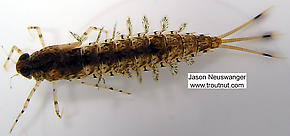 View 3 PicturesThis nymph has double front tarsal claws (Tarsal claw: The claws at the tip of the tarsus, on an insect's "foot.") and double gills on the first three abdominal segments.
View 3 PicturesThis nymph has double front tarsal claws (Tarsal claw: The claws at the tip of the tarsus, on an insect's "foot.") and double gills on the first three abdominal segments.
 View 3 PicturesThis nymph has double front tarsal claws (Tarsal claw: The claws at the tip of the tarsus, on an insect's "foot.") and double gills on the first three abdominal segments.
View 3 PicturesThis nymph has double front tarsal claws (Tarsal claw: The claws at the tip of the tarsus, on an insect's "foot.") and double gills on the first three abdominal segments.Collected March 1, 2004 from unknown in Wisconsin
Added to Troutnut.com by Troutnut on January 25, 2006
Added to Troutnut.com by Troutnut on January 25, 2006
Maccaffertium vicarium (March Brown) Mayfly Nymph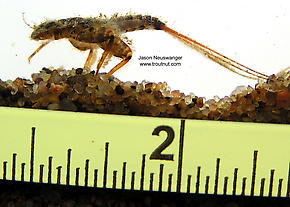 View 3 Pictures
View 3 Pictures
 View 3 Pictures
View 3 PicturesCollected March 1, 2004 from unknown in Wisconsin
Added to Troutnut.com by Troutnut on January 25, 2006
Added to Troutnut.com by Troutnut on January 25, 2006
Hexagenia limbata (Hex) Mayfly Nymph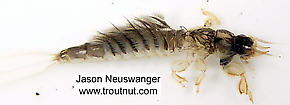 View 3 Pictures
View 3 Pictures
 View 3 Pictures
View 3 PicturesCollected March 1, 2004 from unknown in Wisconsin
Added to Troutnut.com by Troutnut on January 25, 2006
Added to Troutnut.com by Troutnut on January 25, 2006
Maccaffertium vicarium (March Brown) Mayfly Nymph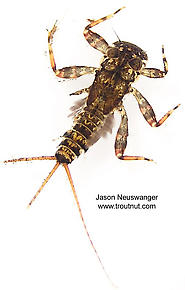 View 3 Pictures
View 3 Pictures
 View 3 Pictures
View 3 PicturesCollected March 1, 2004 from unknown in Wisconsin
Added to Troutnut.com by Troutnut on January 25, 2006
Added to Troutnut.com by Troutnut on January 25, 2006
Siphloplecton basale (Pseudo-Gray Drake) Mayfly Nymph View 3 PicturesThis nymph has double front tarsal claws (Tarsal claw: The claws at the tip of the tarsus, on an insect's "foot.") and double gills on the first three abdominal segments.
View 3 PicturesThis nymph has double front tarsal claws (Tarsal claw: The claws at the tip of the tarsus, on an insect's "foot.") and double gills on the first three abdominal segments.
 View 3 PicturesThis nymph has double front tarsal claws (Tarsal claw: The claws at the tip of the tarsus, on an insect's "foot.") and double gills on the first three abdominal segments.
View 3 PicturesThis nymph has double front tarsal claws (Tarsal claw: The claws at the tip of the tarsus, on an insect's "foot.") and double gills on the first three abdominal segments.Collected March 1, 2004 from unknown in Wisconsin
Added to Troutnut.com by Troutnut on January 25, 2006
Added to Troutnut.com by Troutnut on January 25, 2006
Hexagenia limbata (Hex) Mayfly Nymph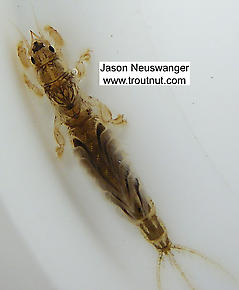 View 3 Pictures
View 3 Pictures
 View 3 Pictures
View 3 PicturesCollected March 1, 2004 from unknown in Wisconsin
Added to Troutnut.com by Troutnut on January 25, 2006
Added to Troutnut.com by Troutnut on January 25, 2006
Hexagenia limbata (Hex) Mayfly Nymph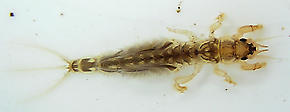 View 3 Pictures
View 3 Pictures
 View 3 Pictures
View 3 PicturesCollected March 1, 2004 from unknown in Wisconsin
Added to Troutnut.com by Troutnut on January 25, 2006
Added to Troutnut.com by Troutnut on January 25, 2006
Leptophlebia cupida (Borcher Drake) Mayfly Nymph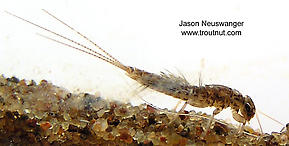 View 3 Pictures
View 3 Pictures
 View 3 Pictures
View 3 PicturesCollected March 1, 2004 from the West Fork of the Chippewa River, Headwaters in Wisconsin
Added to Troutnut.com by Troutnut on January 25, 2006
Added to Troutnut.com by Troutnut on January 25, 2006
Maccaffertium (March Browns and Cahills) Mayfly Nymph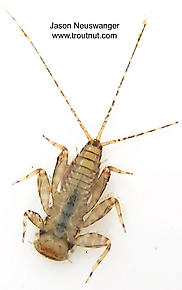 View 3 Pictures
View 3 Pictures
 View 3 Pictures
View 3 PicturesCollected March 1, 2004 from unknown in Wisconsin
Added to Troutnut.com by Troutnut on January 25, 2006
Added to Troutnut.com by Troutnut on January 25, 2006
Calopteryx Damselfly Nymph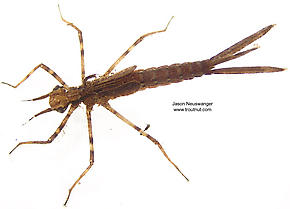 View 2 Pictures
View 2 Pictures
 View 2 Pictures
View 2 PicturesCollected March 1, 2004 from unknown in Wisconsin
Added to Troutnut.com by Troutnut on January 25, 2006
Added to Troutnut.com by Troutnut on January 25, 2006
Hexagenia limbata (Hex) Mayfly Nymph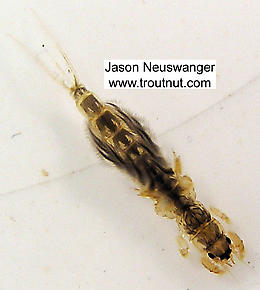 View 2 Pictures
View 2 Pictures
 View 2 Pictures
View 2 PicturesCollected March 1, 2004 from unknown in Wisconsin
Added to Troutnut.com by Troutnut on January 25, 2006
Added to Troutnut.com by Troutnut on January 25, 2006
Calopteryx Damselfly Nymph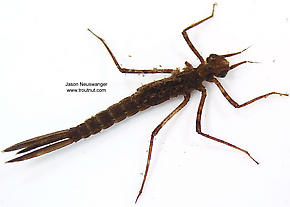 View 2 Pictures
View 2 Pictures
 View 2 Pictures
View 2 PicturesCollected March 1, 2004 from unknown in Wisconsin
Added to Troutnut.com by Troutnut on January 25, 2006
Added to Troutnut.com by Troutnut on January 25, 2006
Tipulidae (Crane Flies) Crane Fly Larva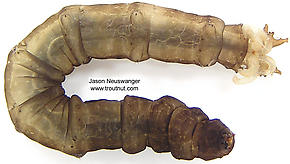 View 2 Pictures
View 2 Pictures
 View 2 Pictures
View 2 PicturesCollected March 1, 2004 from unknown in Wisconsin
Added to Troutnut.com by Troutnut on January 25, 2006
Added to Troutnut.com by Troutnut on January 25, 2006
Siphloplecton (Pseudo-Gray Drakes) Mayfly Nymph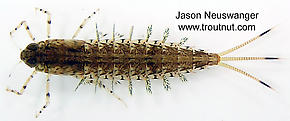 View 3 PicturesThis nymph has double front tarsal claws (Tarsal claw: The claws at the tip of the tarsus, on an insect's "foot.") and double gills on the first three abdominal segments. This one has a distinct dorsal (Dorsal: Top.) stripe.
View 3 PicturesThis nymph has double front tarsal claws (Tarsal claw: The claws at the tip of the tarsus, on an insect's "foot.") and double gills on the first three abdominal segments. This one has a distinct dorsal (Dorsal: Top.) stripe.
 View 3 PicturesThis nymph has double front tarsal claws (Tarsal claw: The claws at the tip of the tarsus, on an insect's "foot.") and double gills on the first three abdominal segments. This one has a distinct dorsal (Dorsal: Top.) stripe.
View 3 PicturesThis nymph has double front tarsal claws (Tarsal claw: The claws at the tip of the tarsus, on an insect's "foot.") and double gills on the first three abdominal segments. This one has a distinct dorsal (Dorsal: Top.) stripe.Collected March 1, 2004 from unknown in Wisconsin
Added to Troutnut.com by Troutnut on January 25, 2006
Added to Troutnut.com by Troutnut on January 25, 2006
Hexagenia limbata (Hex) Mayfly Nymph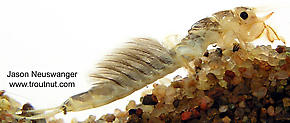 View 2 Pictures
View 2 Pictures
 View 2 Pictures
View 2 PicturesCollected March 1, 2004 from unknown in Wisconsin
Added to Troutnut.com by Troutnut on January 25, 2006
Added to Troutnut.com by Troutnut on January 25, 2006
Leptophlebia cupida (Borcher Drake) Mayfly Nymph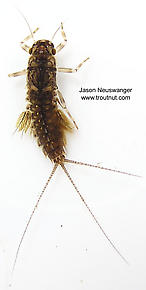 View 2 Pictures
View 2 Pictures
 View 2 Pictures
View 2 PicturesCollected March 1, 2004 from the West Fork of the Chippewa River, Headwaters in Wisconsin
Added to Troutnut.com by Troutnut on January 25, 2006
Added to Troutnut.com by Troutnut on January 25, 2006
Maccaffertium vicarium (March Brown) Mayfly Nymph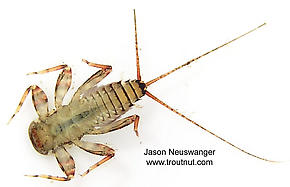 View 2 Pictures
View 2 Pictures
 View 2 Pictures
View 2 PicturesCollected March 1, 2004 from unknown in Wisconsin
Added to Troutnut.com by Troutnut on January 25, 2006
Added to Troutnut.com by Troutnut on January 25, 2006
Baetidae (Blue-Winged Olives) Mayfly Nymph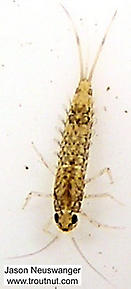 View 2 Pictures
View 2 Pictures
 View 2 Pictures
View 2 PicturesCollected March 1, 2004 from unknown in Wisconsin
Added to Troutnut.com by Troutnut on January 25, 2006
Added to Troutnut.com by Troutnut on January 25, 2006
Ephemera simulans (Brown Drake) Mayfly Nymph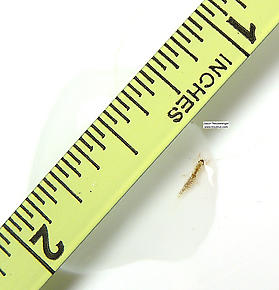 View 2 PicturesHere's an unusually small early instar (Instar: Many invertebrates molt through dozens of progressively larger and better-developed stages as they grow. Each of these stages is known as an instar. Hard-bodied nymphs typically molt through more instars than soft-bodied larvae.) nymph.
View 2 PicturesHere's an unusually small early instar (Instar: Many invertebrates molt through dozens of progressively larger and better-developed stages as they grow. Each of these stages is known as an instar. Hard-bodied nymphs typically molt through more instars than soft-bodied larvae.) nymph.
 View 2 PicturesHere's an unusually small early instar (Instar: Many invertebrates molt through dozens of progressively larger and better-developed stages as they grow. Each of these stages is known as an instar. Hard-bodied nymphs typically molt through more instars than soft-bodied larvae.) nymph.
View 2 PicturesHere's an unusually small early instar (Instar: Many invertebrates molt through dozens of progressively larger and better-developed stages as they grow. Each of these stages is known as an instar. Hard-bodied nymphs typically molt through more instars than soft-bodied larvae.) nymph.Collected March 1, 2004 from unknown in Wisconsin
Added to Troutnut.com by Troutnut on January 25, 2006
Added to Troutnut.com by Troutnut on January 25, 2006
Most recent comments on this post (latest on top)
Comment on this post
Top 10 Fly Hatches
Top Gift Shop Designs
Eat mayflies.
Top Insect Specimens
Miscellaneous Sites
Troutnut.com is copyright © 2004-2024 Jason
Neuswanger (email Jason). See my FAQ for information about use of my images.
 privacy policy
privacy policy
